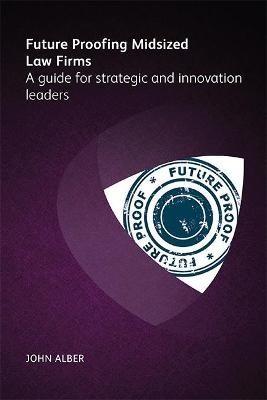
Future-proofing mid-sized law firms
Ark Group (Verlag)
978-1-78358-393-5 (ISBN)
- Titel nicht im Sortiment
- Artikel merken
We will begin this inquiry into innovating to “future-proof” our practices, not with the question of how to innovate, but rather with why we should concern ourselves with innovation. Because if we don’t get the why right, none of the rest of our work on innovation will matter.
We will move on from the question of why innovate to the business context in which all innovation occurs in this age. We won’t dwell on the changes in the legal market already amply covered in the legal press—flat demand, plummeting realization, pressure to price differently, etc. Instead, we’ll explore the broader business climate and technological context in which all practice will operate in the future.
Our starting point will be to explore how profoundly dissatisfied our clients have become with traditional law firm service levels. As cordial as those clients may be over lunch or a round of golf, when truly pressed, most will admit to real frustration with how glacial the pace of change is inside law firms.
Next, we’ll move to a technology focus. This concerns radical shifts in our society that will reshape how we do everything…including law. Technology already in the pipeline will cause breathtaking transformations in our business and personal lives, whether we innovate or not. Changes wrought by this technology will exceed our imagination’s ability to foresee them, will exceed even the ability of our best futurists to predict what will happen.
We will then explore the competitive environment in which Midsize firms will be operating over the near and medium terms. Already, huge shifts in the economics of practice have taken place—largely driven by competitors from outside the traditional legal sector. In order to prepare to meet such emerging competition, you need to understand it.
Next, we will talk about the skill deficits you have to remedy to compete in an age that expects Amazons and Ubers. We can argue about whether law school training properly equips young lawyers for substantive law practice. But there can be no argument about whether young lawyers emerge into practice equipped to manage the business of law—even the basics of it. They clearly do not. And most lawyers leave themselves in that state throughout their careers.
From there, we will explore particular skills in more depth. In separate chapters, we will talk about:
- Developing a baseline of service design skills using Design Thinking resources that are now available to lawyers,
- Building a profit model and other business metrics capabilities that are essential as a means of measuring the efficacy of our innovation efforts,
- Adding project management skills to firms to enhance our ability to manage both the everyday complexities of practice, as well as to carry off ambitious innovation initiatives,
- Learning how to deconstruct and rebuild business processes so as to remove cost and add efficiency. This is the area in which our clients are most interested in seeing us innovate. Maybe we should cultivate those skills.
For all the gloomy predictions about rising competition and increasing price pressure that you’ll find in the pages that follow, I hope you emerge from this study with a sense of optimism. I’m not the only student of this portion of the legal sector to see the opportunities in store for firms that seek to become change leaders.
JOHN ALBER John Alber serves as Futurist for the International Legal Technology Association and for the Institute for the Future of Law Practice. He writes, speaks and consults on the need to reshape the delivery of legal services to suit a future demanding excellence far beyond substantive legal skills. John has served as a transportation industry CEO, as a practicing attorney and as a law firm leader. During his 16 year tenure as Bryan Cave’s Strategic Innovation Partner, that firm came to be recognized as one of the most innovative law firms in the world. While at Bryan Cave, he also served for 7 years on the firm's Operating Group (its management committee). At Bryan Cave, John created one of the first practice economics consulting groups, one of the first client facing software development groups, and one of the first in-firm legal process outsourcing (LPO) organizations. The groups he created developed innovative web-based, client-centric applications that delivered legal advice to clients, managed complex workflows and even created pleadings automatically. They also developed client-facing knowledge management, project management, project estimation and business intelligence systems and highly technology- leveraged alternative staffing solutions for engagements of all types. John is an Emeritus fellow of the College of Law Practice Management. He has received a number of awards, both in the legal field and in information technology generally. Among other awards, he received ILTA's first ever Premiership Award, was named American Lawyer Media’s first ever ‘Champion of Technology', was given a Lifetime Achievement Award by Law Technology News and recognized as one of the ‘Top 25 CTOs’ in the world by Infoworld. In addition, while under his leadership, Bryan Cave received recognition as a CIO Magazine ‘Top 100 Company' and was twice recognized as ILTA’s Most Innovative Firm.
Contents
Executive summary
About the author
Selected publications
An introduction to the future
Section 1: A legal innovation primer
Chapter 1: Why innovate?
Chapter 2: How the Information Revolution will destroy law’s economic model
Chapter 3: Service is the real revolution
Chapter 4: Client dissatisfaction is an engine of opportunity
Chapter 5: Blockchain technology and the corporate self-help revolution
Chapter 6: Entrepreneurial firms will turn ELM systems to competitive advantage
Chapter 7: What the competition looks like – ALSPs and other New Law entities
Chapter 8: Recognizing and overcoming internal barriers to innovation
Chapter 9: Structuring for innovation
Chapter 10: Where AI fits in a future-proofing strategy
Section 2: Six steps toward transforming legal service delivery
Chapter 11: Do client feedback like you mean it
Chapter 12: Bring Information Age business skills to your firm
Chapter 13: Become measurably better at business operations and client
Chapter 14: Start doing process management with your own documents
Chapter 15: Make legal project management a discipline rather than an accident
Chapter 16: Institutionalize service innovation in your practices
| Erscheinungsdatum | 07.07.2020 |
|---|---|
| Sprache | englisch |
| Themenwelt | Recht / Steuern ► EU / Internationales Recht |
| Recht / Steuern ► Privatrecht / Bürgerliches Recht ► Berufs-/Gebührenrecht | |
| ISBN-10 | 1-78358-393-2 / 1783583932 |
| ISBN-13 | 978-1-78358-393-5 / 9781783583935 |
| Zustand | Neuware |
| Haben Sie eine Frage zum Produkt? |
aus dem Bereich


